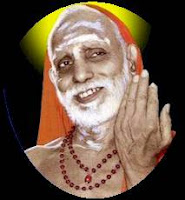தெய்வத்தின் குரல் (மூன்றாம் பாகம்) - தெய்வ தத்வம் தெய்வங்கள்.
விலையுயர்ந்த ரத்னமொன்று நம்மிடமிருந்தால் வீட்டிலே எங்கே வைப்போம்? வாசல் புற ரூமில் வைப்போமா? தோட்டத்தைச் சேர உள்ள ரூமில் வைப்போமா? ரொம்பவும் காபந்தமாக மத்தியில் இருக்கிற ரூமில் இரும்புப் பெட்டியில்தான் வைப்போம். அப்படியே வேதத்தில் ஜீவரத்னமான சிவநாமத்தை ரொம்பவும் ஜாக்ரதைப்படுத்தி வைத்திருக்கிறது. நாலில் மத்தி இரண்டாவது. நாலு வேதங்களில் இரண்டாவது யஜுஸ். அதர்வவேதத்தைச் சேர்க்காமல் ரிக், யஜுஸ், ஸாமம் என்ற மூன்றை மட்டும் 'த்ரயீ' என்பதுண்டு. அப்போதும் ரிக்குக்கும் ஸாமத்துக்கும் நடுவில் வருது யஜுஸே. யஜுஸிலேயே சுக்ல யஜுஸ், க்ருஷ்ண யஜுஸ், என்று இரண்டு இருப்பதால் நாலு வேதத்தை நாலு வேதத்தை ஐந்து என்று ஆக்கினாலும் ரிக், சுக்ல யஜுஸ், க்ருஷ்ண யஜுஸ், ஸாமம், அதர்வம் என்ற ஐந்தில் நட்ட நடுவாக வருவது மூன்றாவதான க்ருஷ்ண யஜுஸ்தான் இந்த க்ருஷ்ண யஜுர் வேதத்தில் மத்ய பாகம் அதன் நாலாவது காண்டம். அந்தக் காண்டத்தின் மத்யம் ஐந்தாவது ப்ரச்னம். இதிலேதான் நடுவில் ஸ்ரீ ருத்ர ஸூக்தம் என்படுவதில் நடுநாயகமாக பஞ்சாக்ஷரம் வருகிறது. அந்த பஞ்சாக்ஷரத்துக்கும் மையமாக 'சிவ' என்ற த்வயக்ஷரம் இருக்கிறது.
விலையுயர்ந்த ரத்னமொன்று நம்மிடமிருந்தால் வீட்டிலே எங்கே வைப்போம்? வாசல் புற ரூமில் வைப்போமா? தோட்டத்தைச் சேர உள்ள ரூமில் வைப்போமா? ரொம்பவும் காபந்தமாக மத்தியில் இருக்கிற ரூமில் இரும்புப் பெட்டியில்தான் வைப்போம். அப்படியே வேதத்தில் ஜீவரத்னமான சிவநாமத்தை ரொம்பவும் ஜாக்ரதைப்படுத்தி வைத்திருக்கிறது. நாலில் மத்தி இரண்டாவது. நாலு வேதங்களில் இரண்டாவது யஜுஸ். அதர்வவேதத்தைச் சேர்க்காமல் ரிக், யஜுஸ், ஸாமம் என்ற மூன்றை மட்டும் 'த்ரயீ' என்பதுண்டு. அப்போதும் ரிக்குக்கும் ஸாமத்துக்கும் நடுவில் வருது யஜுஸே. யஜுஸிலேயே சுக்ல யஜுஸ், க்ருஷ்ண யஜுஸ், என்று இரண்டு இருப்பதால் நாலு வேதத்தை நாலு வேதத்தை ஐந்து என்று ஆக்கினாலும் ரிக், சுக்ல யஜுஸ், க்ருஷ்ண யஜுஸ், ஸாமம், அதர்வம் என்ற ஐந்தில் நட்ட நடுவாக வருவது மூன்றாவதான க்ருஷ்ண யஜுஸ்தான் இந்த க்ருஷ்ண யஜுர் வேதத்தில் மத்ய பாகம் அதன் நாலாவது காண்டம். அந்தக் காண்டத்தின் மத்யம் ஐந்தாவது ப்ரச்னம். இதிலேதான் நடுவில் ஸ்ரீ ருத்ர ஸூக்தம் என்படுவதில் நடுநாயகமாக பஞ்சாக்ஷரம் வருகிறது. அந்த பஞ்சாக்ஷரத்துக்கும் மையமாக 'சிவ' என்ற த்வயக்ஷரம் இருக்கிறது.
























